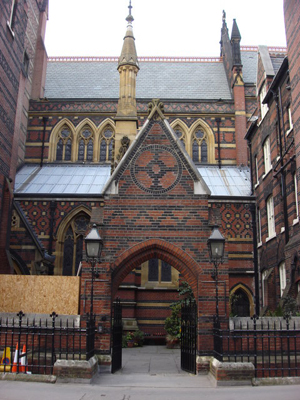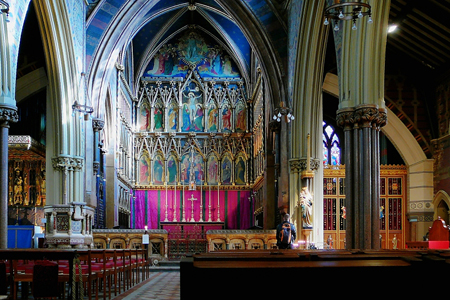| |
 |
 |
 |
| Comment on this report, or find other reports. |
 |
| Our Mystery Worshippers are volunteers who warm church pews for us around the world. If you'd like to become a Mystery Worshipper, start here. |
 |
| Find out how to reproduce this report in your church magazine or website. |
|
|
| 1921: All Saints
Margaret Street, London |
 |

Photo: Russ London |
 |
Mystery Worshipper:
Cool Dude.
The church:
All
Saints Margaret Street, London.
Comment: We have received a comment on this report.
Denomination:
Church of England, Diocese
of London.
The building:
All Saints was the work of the Gothic Revival architect William
Butterfield, who was closely associated with the Oxford Movement
and was responsible for about a hundred ecclesiastical structures
in England, Scotland, the United States and Australia. The church
was designed as a manifesto building, demonstrating everything
that should be observed in church architecture by the Victorian
Anglo-Catholic. It was commissioned by a group of Tractarians
in 1841 and completed a decade later, and the liturgy and worship
within are as much a manifesto for Anglo-Catholics as the building.
The church:
This is a gathered community from all over central London, quite
mixed socially, but almost entirely in late middle age or elderly.
There is not much modern about this church; it is almost a time
warp experience, a visit to pre-war Britain, or perhaps the
setting of a Barbara Pym novel, just post WWII. But the seriousness
and lack of pomposity are welcoming, not at all off-putting
for me. The fact that they sail forward regardless of fads and
fashions (or rather without updating their the ecclesiastical
fashions) is rather admirable.
The neighbourhood:
There are very few people living nearby, and the surrounding
streets just north of Oxford Street are the hub of the UK high
street rag trade and advertising industries.
The cast:
The Revd Alan Moses, vicar, and two other priests who I believe
were the Revd Gerald Beauchamp, assistant priest, and the Revd
Julian Browning, honorary assistant priest. All were vested
simply in cassock and surplice. Their role throughout the service
was minimal, but they did make a shockingly loud noise at the
end (see below).
The date & time:
Wednesday, 31 March 2010, 7.30pm.
What was the name of the service?
Tenebrae.
How full was the building?
Reasonably full – about 100 filling the nave, though the aisles
were empty.
Did anyone welcome you personally?
Someone was giving out the service sheets and bid us a good evening in welcoming but hushed tones.
Was your pew comfortable?
It was a modern chair and the rail of its back cut into my back
uncomfortably.
How would you describe the pre-service
atmosphere?
Silence was kept and the church was not fully lit. Five minutes
before the service, even more of the electric lights were turned
out and a row of benediction candles was lit. A pious altar
boy (rather an altar man, as even they are middle aged here)
lit six candles high on the altar, so high he could barely reach
them. This collective silence and darkness in the heart of London,
just a few yards from the materialistic frenzy of Oxford Street,
was powerfully calming and created an air of expectation.
What were the exact opening words of the
service?
"The zeal of thine house hath even eaten me." But
these were preceded by the Lord's Prayer, the Hail Mary and
the Apostles Creed recited silently by all.
What books did the congregation use during the
service?
A special booklet was handed out giving most of the words except
for the five lessons. These were from from the Lamentations
of Jeremiah and Paul's Epistle to the Church in Corinth. The
whole service was sung and did not require responses from the
congregation. In the beautifully clear acoustic you could really
have dispensed with the booklet and simply listened to the words
being sung.
What musical instruments
were played?
None. The whole service was sung without accompaniment. Fortunately,
the choir at All Saints is exemplary, comprised of professional
musicians and students from the London conservatories. So the
glorious Renaissance music by Lodovico Grossi da Viadana, Tomás
Luis de Victoria, Orlandus Lassus and others was sung with more
precision than in many concert halls. But here it was offered
in its proper setting, without ego or the desire to win an encore.
It was offered for the power of its spiritual directness.

Photo: Oxyman
Did anything distract
you?
The altar man trying, and at first failing, to light one of
the impossibly high altar candles provided some amusement before
the start. But after that I was wrapped up in the divine office.
Was the worship stiff-upper-lip,
happy clappy, or what?
It was monastic in its simplicity, length and pace. It reminded
me of sitting in monasteries hearing the offices of the day
– and that is indeed where this service has its roots.
Tenebrae ("darkness") is a mixture of the monastic
offices of matins, lauds and none, which were originally sung
on the three final days of Holy Week but over time came to be
anticipated as a single service. It began in relative darkness,
but as it progressed candles were extinguished two by two until
the church was in complete darkness. The Miserere was
sung in the pitch blackness, an unusual and moving experience.
Then after a silence, the three clergy made a sudden loud noise
by walloping the choir stalls (I couldn't see, of course, so
I am guessing here) – symbolising the earthquake at the
Resurrection, and one candle representing the risen Christ was
rekindled.
Exactly how long was the
sermon?
There wasn't one.
Which part of the service
was like being in heaven?
Most of it. There were one or two moments early on when I wanted
more involvement. Then I let go and relaxed into the monastic
spirituality of the service and the exceptionally beautiful
music.
And which part was like
being in... er... the other place?
For a service that involved sitting for most of the time, the
chair became increasingly uncomfortable.
What happened when you hung around after the service looking lost?
We all filed out of the church slowly and in silence. No coffee
or chat, no tombola (raffle ticket sales) or notices.
How would you describe
the after-service coffee? N/A.
How would you feel about making this church your regular (where 10 = ecstatic, 0 = terminal)?
I cannot give a rating. Tenebrae is an unusual service these
days, even in Anglo-Catholic outfits, and is only held once
a year. But the opportunity to experience this rare spiritual
expression, especially sung so beautifully, is one that attracts
me to this church.
Did the service make you feel glad to be a
Christian?
Yes.
What one thing will you remember about all this in seven days' time?
The Miserere in the darkness. |
|
|
 |
 |
 |
| We rely on voluntary donations to stay online. If you're a regular visitor to Ship of Fools, please consider supporting us. |
 |
 |
 |
| The Mystery Pilgrim |
 |
| One of our most seasoned reporters makes the Camino pilgrimage to Santiago de Compostela in Spain. Read here. |
 |
 |
 |
| London churches |
 |
| Read reports from 70 London churches, visited by a small army of Mystery Worshippers on one single Sunday. Read here. |
| |
|
|
|
|


